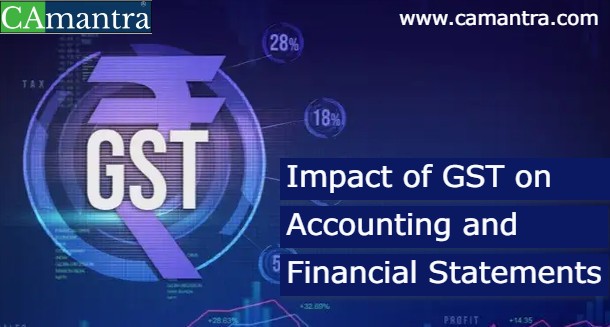GST has been introduced on 1st July 2017, India has moved towards a single indirect tax regime for goods & services with uniform accounting system under GST for entire country. Some provisions which have directly affected on accounting such as Works Contract, Composite Supply and many more.
What is Dual model of Tax?
All transaction of supply would be subject to 2 Levies (State and Union government) and levied is shared between two.
There are 4 Types of Levies:-
- CGST (Central Goods and Service Tax)
- SGST (State Goods and Service Tax)
- IGST (Integrated Goods and Service Tax)
- Compensation Cess
There Are Two Transactions in Every Business: –
- Outward Supply (Sales) reported in GSTR 1
- Inward Supply (Purchase) auto populated in GSTR2A
It can be divided into three broad area –
- Input
- Output and
- Tax payable
Generally below mentioned to be maintained by a normal taxpayers under GST: –
- Input CGST Account
- Input SGST Account
- Input IGST Account
- Output CGST Account
- Output SGST Account
- Output IGST Account
- GST Payable Account
- Input & output Cess (If applicable)
Illustrative example of business transactions under GST
- Outward supplies ( Inter or Intra state)
- Inward Supplies ( Inter or Intra state)
- Set Off of ITC Against Out Tax Liability
- Refunds in Case of Export of Goods & Services
- Imports
- Reverse Charge Transactions
Expenses can be divided into these categories under GST
- Expenses on which ITC availed
- Expenses on which ITC NOT availed
- Expenses on which GST paid on RCM
- Expenses on which no GST charged by supplier as below threshold
- Expenses with zero rated GST
- Expenses on which GST not leviable
Following records to be maintained under GST
- Stock records
- Inward & outward supply of goods/ services
- ITC availed
- Tax Invoice
- Bill of Supply
- Debit note/ credit notes
- Receipt/ Payment/ Refund voucher
Impact of GST transaction on Financial Statements
These Checklist will help you: –
- Reconcile your Outward and Inward Supply
- Check eligibility of Input tax credit under section 16 read with rules
- Reverse Charge Mechanism [RCM – Sec 9(3)]
- Reconcile with Cash & Credit Ledger balances
- ITC Wrongly Availed and not availed
- Income Accrued as per income tax but not liable to GST
- Advance Received against services (Not Goods)
Reconcile your Outward & Inward Supply
- Reconcile your outward & inward supply with GST Invoices, debit & credit Note/documents issued during FY.
- As per BOA with GST return (GSTR 3B and GSTR 1/GSTR 2A )
- Reconcile your Turnover with 26 AS
- Reconcile Turnover with GST TDS(If applicable)
Check ITC Eligibility u/s 16 read with rules
- Check eligibility of ITC as per section 16 & Rule 36.
- Reverse ITC if not cover under eligibility criteria
- According to the provision of Section 16 (2) (d) related to payment to vendor within 180 days from date of invoice issuance , Reverse ITC along with interest, if payment not done by adding in outward supply.
- Record in financial statement as current liability.
- If payment is made in subsequent period then re- avail ITC up to Sep’2021 Return for FY 20-21.
Reverse Charge Mechanism [RCM – Sec 9(3)]
- Review the financial statements of FY 2020-21 identify expenses subject to RCM according to the Sec 9(3).
- Reconcile GST liability on above with RCM liability discharged by GSTR 3B and/or DRC 03.
- Discharged GST liability under RCM along with interest if not paid and also avail ITC in the subsequent returns till return for the period of Sep’21 for FY 2020-21
Reconcile with Cash & Credit Ledger balance
- Reconcile financial book of account with cash & credit ledger of GSTN portal.
- Record in your financial statements as current assets of Cash & credit balance reflecting in GST portal.
- Identify justify reason for non-reconcile & preserve in records for future departmental audit.
ITC Wrongly Availed
- ITC wrongly availed of the inputs covered under section 17(5) of CGST Act (Block Credit)
- ITC Wrongly availed not complying with provisions of Rule 36(4).
- ITC not reversed considering Rule 42 / 43
- Identify those ITC reverse them in upcoming Returns and prepare Reconciliation
- Discharge Interest on reversal if same is utilized.
- Record in Financial Statements on as Current liability.
ITC Not Availed
- Record all invoices in Books of accounts according to supporting documents.
- Reconcile ITC with Books of accounts, GSTR 2A, Tax invoice of inward supply, debit note from supplier etc.
- Identify ITC missed in GST Returns or BOA.
- Record ITC NOT availed as current asset as ITC receivable.
- ITC availed in subsequent returns up to the Return for the period Sep’21 for FY 20-21.
Income Earned as per Income Tax but not liable to GST
- Identify Income accrued as per Income Tax but not liable to GST in the period in which it is accrued considering time of supply provisions.
- Prepare Reconciliation between Outward supplies according to the Income Tax & GST for future reference.
- Discharge GST liability in subsequent period as per Time of Supply provisions.
- Advance Received against supply of services (Not on supply of Goods)
- Amount received but no invoice is raised against supply of services
- Review your bank statements for receipts against which no invoice is raised.
- According to the CGST Act- sec 12(Time of Supply), GST is payable on advance receipt
- Advance receipt was reflected in the return for the period of receipt but same is not apply for Goods according to the Notification No. 66/2017 – Central Tax.
- Discharged GST liability along with due interest at the time of advance identified against Outward supply of Services, on which GST liability not discharged yet.
- Record as Current assets in financial statements as GST Paid on Advance.

